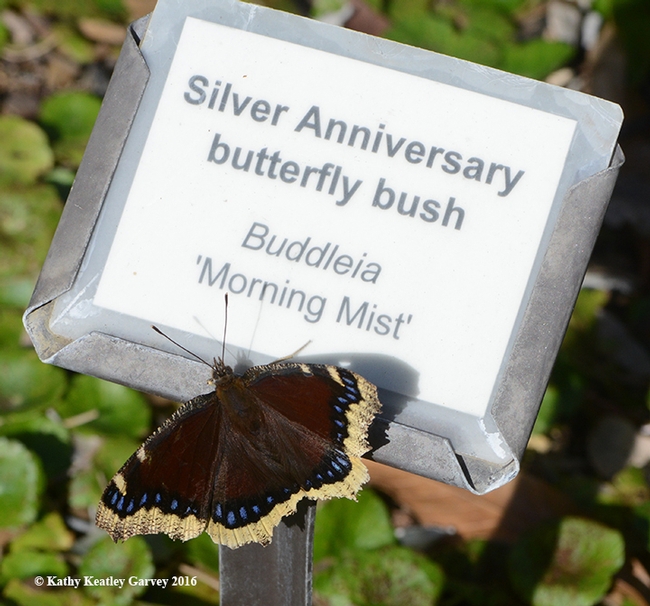If you go looking for a bumble bee, you might find a butterfly.
And vice versa.
The UC Davis Arboretum last Saturday (Feb. 6), was just starting to "get its spring on." We spotted a few honey bees and syrphid flies foraging on daphne (Daphne odora) in the Ruth Risdon Storer Garden, but nearby, in the Carolee Shields White Flower Garden and Gazebo, a single butterfly fluttered down on a silver anniversary butterfly bush (Buddleia “Morning Mist").
Could it be? It was. A mourning cloak, Nymphalis antiopa. Butterfly guru Art Shapiro, distinguished professor of evolution and ecology, said "Congratulations--good show. The first spotting (of the year) in the Valley." Shapiro has monitored the butterfly populations of the Central Valley for more than four decades, and posts his research on his website.
After perching on the butterfly bush, the mourning cloak soared high and then touched down on the sign that read "Silver Anniversary Butterfly Bush. Buddleia “Morning Mist.” What are the odds?
On his website, Shapiro describes the mourning cloak as a "very distinctive and charismatic butterfly, best known for its conspicuous activity in late winter, flying and acting territorial before any trees have leafed out or any wildflowers are active...in recent years populations of this butterfly have collapsed regionally; it disappeared from West Sacramento for several years and has been very scarce and erratic at other low-altitude sites; there was some improvement in 2005 and numbers of hibernators at low altitude were up in 2006, but very bad weather may have prevented much if any recovery."
Shapiro has seen two this year at higher elevations but not in the valley--yet. "In the Sacramento Valley there appears to be only one brood (in spring); the resulting adults migrate upslope and breed in the mountains," he says on his website. "There is a reverse downslope migration by the next generation, in late September-October. It is not obvious why this seasonal altitudinal migration occurs, but both the California and Milbert's Tortoiseshells, its closest relatives, do it, too."
The mourning cloak, native to Europe and North America and widespread throughout the world, is the state insect of Montana. It's distinguished by its purple-black color, iridescent blue spots, and a yellow border on its upperside. The adults feed on oak tree sap, rotting fruit, and "occasionally on flower nectar," according to Butterflies and Moths of North America. Caterpillar hosts are willows including black willow (Salix nigra), weeping willow (S. babylonica), and silky willow (S. sericea); also American elm (Ulmus americana), cottonwood (Populus deltoides), aspen (P. tremuloides), paper birch (Betula papyrifera), and hackberry (Celtis occidentalis). Older caterpillars wander about and may be found on plants that they do not eat."
The UC Davis Arboretum will be the site of scores of visitors on Saturday, Feb. 13 during the fifth annual UC Davis Biodiversity Museum Day. The campuswide event, free and open to the public, will take place at 11 different sites:
- Anthropology Collections, Young Hall, open noon to 4 p.m.
- Arboretum, Headquarters along LaRue Road, open 10 a.m. to 4 p.m.
- Bohart Museum of Entomology, Academic Surge Building, open noon to 4 p.m.
- Botanical Conservatory, greenhouses along Klieber Hall Drive, open 10 a.m. to 4 p.m.
- California Raptor Center, Old Davis Road, open 9 a.m. to noon
- Center for Plant Diversity, Sciences Lab Building, open 1 p.m. to 4 p.m.
- Häagen-Dazs Honey Bee Haven, Bee Biology Road, open 1 p.m. to 4 p.m.
- Museum of Wildlife and Fish Biology, Academic Surge Building, open noon to 4 p.m.
- Nematode Collection, Sciences Lab Building, open 1 to 4 p.m.
- Paleontology Collections, Earth and Physical Sciences Building, open 11 a.m. to 3 p.m.
- Phaff Yeast Culture Collection, Earth and Physical Sciences Building, open 11 a.m. to 3 p.m.
And maybe--just maybe--visitors to the UC Davis Arboretum will see a mourning cloak.
Or maybe the first bumble bee of the year...a queen black-tailed bumble bee, Bombus melanopygus?
If you go looking for a butterfly, you might find a bumble bee.
Attached Images:

A mourning cloak, Nymphalis antiopa, as photographed Feb. 6, 2016 in the Carolee Shields White Flower Garden and Gazebo, UC Davis Arboretum. (Photo by Kathy Keatley Garvey)

Mourning cloak touches down Feb. 6, 2016 on a butterfly bush, Buddleia "Morning Mist," in the Carolee Shields White Flower Garden and Gazebo, UC Davis Arboretum. (Photo by Kathy Keatley Garvey)